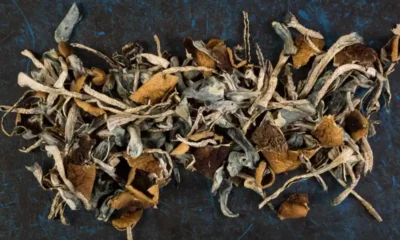Connect with us
Published
6 months agoon

Psychedelic-assisted psychotherapy merges the principles of talk therapy with the effects of psychedelics. Many people seeking help with depression, PTSD, anxiety, or other mental health conditions have tried one or the other.
Some notable research includes looking at the use of psilocybin, one of the psychoactive components of magic mushrooms, to treat anxiety experienced by patients with metastatic cancers. Other studies spotlight the use of psychedelic therapy to help patients receiving hospice care cope with feelings of depression and hopelessness.
Such studies suggest that people, especially those with terminal illnesses like cancer, experience profound psychological transformations in a single six-hour session involving psilocybin when combined with psychotherapy. This dual approach results in a drastic improvement in mood and acceptance of one’s situation.
And now, neuroscientists understand more about how and why these positive outcomes occur. Research indicates that forming new neural connections facilitates assimilating new skills, memories, and attitudes, PsyPost reports. Known as arborization, this process is comparable to the branching of trees, which it’s named after. This happens when neurons create new pathways. This neural growth is crucial in fostering changes in cognition and emotional responses.
Scientists use a method known as two-photon microscopy to examine this phenomenon in living cells. This technique lets them monitor the development and retraction of spines on neurons. Prepare for some science, reader: These neuron spines comprise one part of the synapses, essential for facilitating communication between neurons.
Scientists widely believed that lasting spine formation in the brain required continuous and repetitive mental effort. But, new research from Yale suggests that it could happen quickly and even in one dosage. The scientists observed swift spine formation in the frontal cortex of mice after just a single dose of psilocybin. Obviously, the mice did not receive therapy and integration. But, the study showed that mice administered with psilocybin exhibited around a 10% increase in spine formation. These changes were not fleeting; they were noted one day post-treatment and then persisted for over a month.
Psychoactive compounds mainly alter brain activity by interacting with receptors on neural cells. Among these, the serotonin receptor 5HT, commonly targeted by traditional antidepressants, exists in multiple subtypes. So, there’s more than one way to use them to prompt positive change. Psychedelics like DMT (the key ingredient in ayahuasca) activate a specific receptor subtype known as 5-HT2A. Researchers believe this receptor also plays a crucial role in facilitating hyperplastic states, periods when the brain undergoes rapid changes.
The 5-HT2A receptors, which DMT activates, are found not only on the surface of neuron cells but also within the neuron itself. The famous internal 5-HT2A receptor is key to igniting the rapid changes in neuronal structure. Serotonin is unable to penetrate the cell membrane, which is why people don’t experience hallucinations when taking antidepressants like Prozac or Zoloft (much to many readers taking the mood-elevators distaste). In contrast, psychedelics can cross the cell boundary and influence the internal 5-HT2A receptor, promoting the growth of dendrites and an increase in spine formation.
Besides being the active component in ayahuasca, as readers may know, DMT is also a molecule naturally produced in mammalian brains — including humans.
The fact that our brains make DMT suggests that human neurons can generate their own ‘psychedelic’ molecules (albeit in minuscule amounts). It’s conceivable that the brain employs its own endogenous DMT as a mechanism for adaptation, such as forming dendritic spines on neurons to embed crucial mental states. Ideally, a patient would use therapy in conjunction with these molecular changes for the best possible outcome when seeking help for a mental health condition.
While the brain only makes small amounts of DMT, you may have heard that when we die, there’s a massive burst of it, explaining some of what folks claim to see during near-death experiences. The hypothesis that the brain releases DMT in large quantities at death is a favorite in the psychedelic community; however, it remains a hypothesis without solid scientific backing. Research in this area is challenging not only to any drug laws but also to the ethical and practical difficulties of studying the brain at the moment of death.
However, the psychedelic community must remember that bad trips do happen, and that’s not something you want happening to you or someone that you love in the final days of your life. As PsyPost points out, in “These Precious Days,” a collection of essays by Ann Patchett, she recounts an experience of consuming mushrooms with a friend who was battling pancreatic cancer. Her friend underwent a spiritual and transformative experience, emerging with a heightened connection to her loved ones. Patchett, however, describes her experience differently, likening it to spending eight hours in a dark, nightmarish scenario, akin to being in a cauldron of lava at the Earth’s core, where she felt as if she was constantly battling snakes.
While there’s evidence that psychedelic therapy can do miraculous work, explained by even more miraculous science, even all the Yale researchers and psychonauts in the world can’t prevent with complete certainty the risk of battling snakes in a cauldron of lava at the Earth’s core.


Study Reveals State Cannabis Legalization Lowers Immigrant Deportation


DEA Challenges Bid To Use Psilocybin Under ‘Right To Try’ Legislation


Vegans Rejoice as Farmers Switch from Chickens to Hemp


Louisiana Legislative Committee Unanimously Passes Adult-Use Cannabis Framework Bill


Louisiana House Bill to Regulate Hemp Products Advances Along With Senate Bill to Ban


Cresco Labs Workers Reportedly De-Unionize
